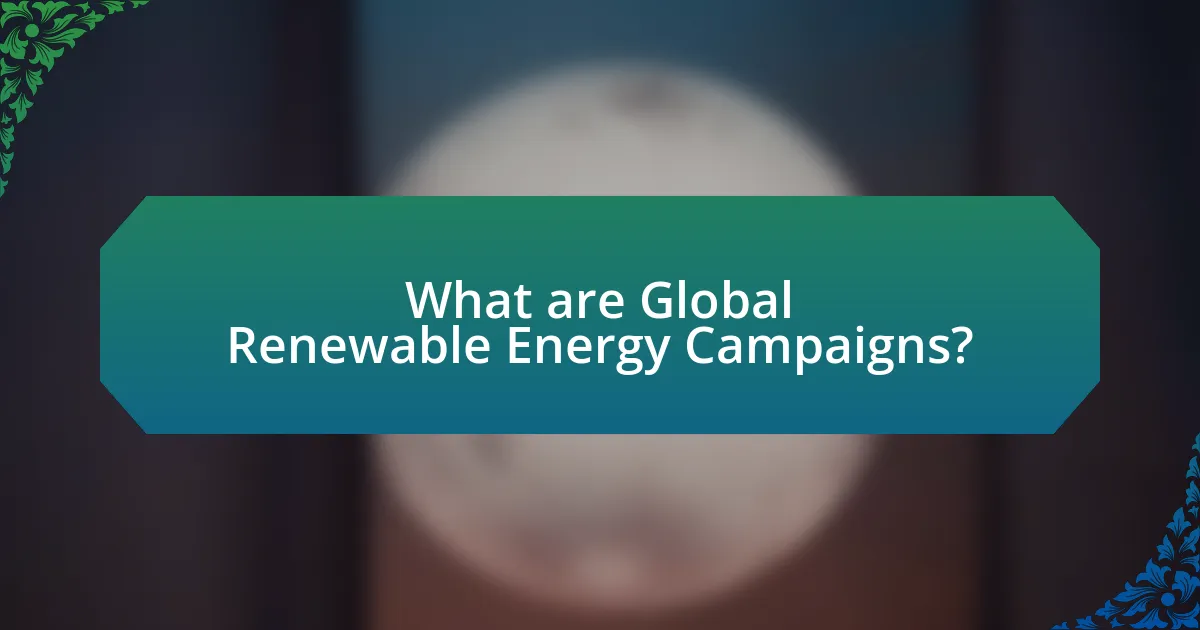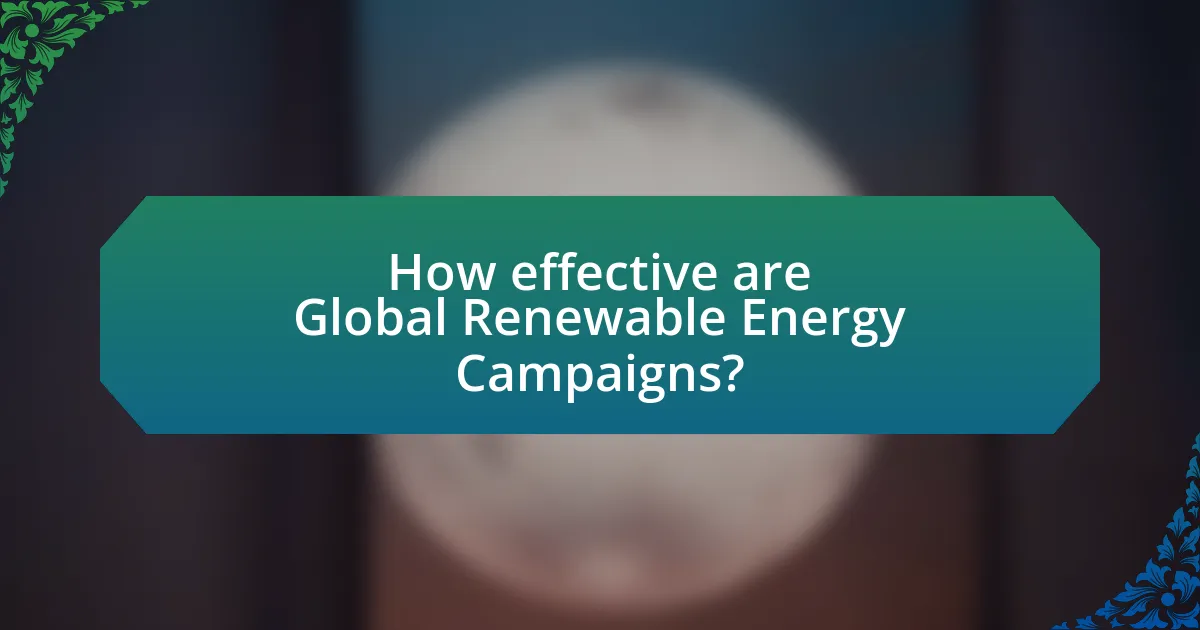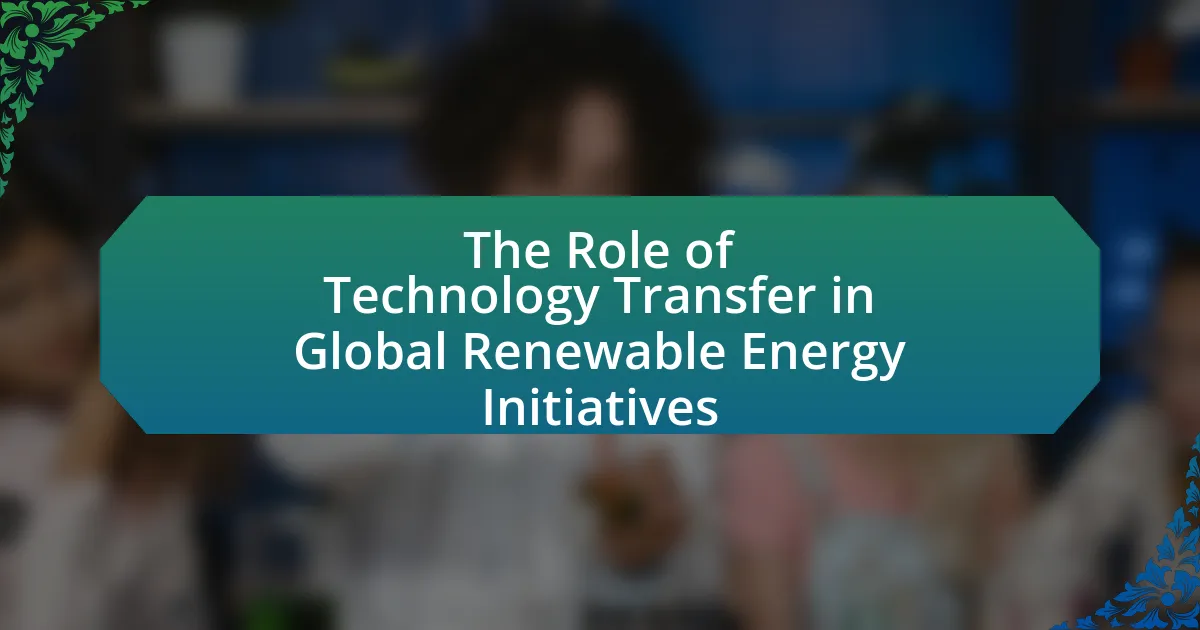Global Renewable Energy Campaigns are structured initiatives designed to promote the adoption of renewable energy sources globally, focusing on advocacy, education, and resource mobilization. These campaigns aim to raise awareness about the benefits of renewable energy, influence policy changes, and engage communities, ultimately contributing to a significant increase in renewable energy capacity and public support. Key stakeholders include government agencies, NGOs, private sector companies, and local communities, all working together to achieve common goals aligned with global energy policies. The effectiveness of these campaigns is measured through metrics such as carbon emissions reduction, energy generation capacity, and public engagement levels, while challenges like political resistance and funding limitations persist. The article analyzes the strategies, outcomes, and lessons learned from successful campaigns, providing insights into enhancing future efforts in promoting renewable energy solutions.

What are Global Renewable Energy Campaigns?
Global Renewable Energy Campaigns are organized efforts aimed at promoting the adoption and implementation of renewable energy sources worldwide. These campaigns often involve advocacy, education, and mobilization of resources to raise awareness about the benefits of renewable energy, such as reducing greenhouse gas emissions and enhancing energy security. For instance, initiatives like the Global Wind Energy Council’s campaigns have successfully increased global wind energy capacity from 7.5 gigawatts in 1997 to over 743 gigawatts in 2020, demonstrating the significant impact these campaigns can have on energy transition.
How do these campaigns aim to promote renewable energy?
These campaigns aim to promote renewable energy by raising awareness, educating the public, and advocating for policy changes that support sustainable practices. For instance, campaigns often utilize social media platforms to disseminate information about the benefits of renewable energy sources, such as solar and wind power, which can reduce greenhouse gas emissions and combat climate change. According to a report by the International Renewable Energy Agency, public awareness campaigns have been shown to increase the adoption of renewable technologies by up to 30% in certain regions. Additionally, these campaigns frequently collaborate with local governments to implement incentives for renewable energy adoption, further reinforcing their impact on energy transition.
What strategies are commonly used in these campaigns?
Common strategies used in global renewable energy campaigns include public awareness initiatives, policy advocacy, and community engagement. Public awareness initiatives aim to educate the general population about the benefits of renewable energy, often utilizing social media and informational campaigns to reach a broad audience. Policy advocacy involves lobbying for supportive legislation and regulations that promote renewable energy adoption, which has been shown to significantly influence government action and investment in clean energy technologies. Community engagement focuses on involving local populations in renewable energy projects, fostering grassroots support, and ensuring that initiatives meet the specific needs of communities, thereby enhancing project acceptance and success. These strategies collectively contribute to the effectiveness of campaigns by increasing visibility, influencing policy, and building local support for renewable energy initiatives.
Who are the primary stakeholders involved in these campaigns?
The primary stakeholders involved in global renewable energy campaigns include government agencies, non-governmental organizations (NGOs), private sector companies, and local communities. Government agencies play a crucial role by setting policies and regulations that promote renewable energy adoption. NGOs often advocate for sustainable practices and raise awareness about renewable energy benefits. Private sector companies invest in and develop renewable energy technologies, while local communities are directly impacted by these initiatives and can influence their success through participation and support. These stakeholders collectively contribute to the effectiveness of renewable energy campaigns by aligning their interests and resources towards common goals.
What are the goals of Global Renewable Energy Campaigns?
The goals of Global Renewable Energy Campaigns are to promote the adoption of renewable energy sources, increase public awareness about climate change, and influence policy changes towards sustainable energy practices. These campaigns aim to reduce greenhouse gas emissions by encouraging the transition from fossil fuels to renewable energy technologies such as solar, wind, and hydroelectric power. For instance, the International Renewable Energy Agency (IRENA) reports that increasing the share of renewables in the global energy mix can significantly mitigate climate change impacts and enhance energy security.
How do these goals align with global energy policies?
The goals of global renewable energy campaigns align with global energy policies by promoting sustainable energy sources that reduce greenhouse gas emissions and enhance energy security. These campaigns support international agreements such as the Paris Agreement, which aims to limit global warming to well below 2 degrees Celsius by transitioning to renewable energy. For instance, the International Renewable Energy Agency (IRENA) reports that increasing the share of renewables in the energy mix is essential for achieving climate targets and fostering economic growth. This alignment is further evidenced by national commitments to renewable energy adoption, which reflect the objectives set forth in global energy frameworks.
What metrics are used to measure the success of these campaigns?
The metrics used to measure the success of global renewable energy campaigns include carbon emissions reduction, energy generation capacity, public engagement levels, and financial investment in renewable technologies. Carbon emissions reduction quantifies the decrease in greenhouse gases resulting from the implementation of renewable energy solutions, providing a direct measure of environmental impact. Energy generation capacity assesses the amount of energy produced from renewable sources, indicating the effectiveness of the campaign in increasing sustainable energy supply. Public engagement levels, often measured through surveys and participation rates, reflect the campaign’s ability to raise awareness and influence behavior towards renewable energy adoption. Financial investment metrics track the amount of funding directed towards renewable projects, showcasing the economic commitment to transitioning to sustainable energy. These metrics collectively provide a comprehensive view of the campaign’s effectiveness in promoting renewable energy initiatives.

How effective are Global Renewable Energy Campaigns?
Global Renewable Energy Campaigns are highly effective in raising awareness and driving policy changes towards sustainable energy solutions. For instance, the Global Wind Energy Council reported that global wind power capacity increased by 93 GW in 2020, largely attributed to advocacy and campaigns promoting renewable energy. Additionally, campaigns like the UN’s “Act on Climate” initiative have mobilized millions, influencing national commitments to reduce carbon emissions. These campaigns not only educate the public but also create a sense of urgency, leading to significant investments in renewable technologies and infrastructure.
What factors contribute to the effectiveness of these campaigns?
The effectiveness of global renewable energy campaigns is primarily influenced by public awareness, policy support, and technological advancements. Public awareness drives engagement and participation, as campaigns that effectively educate the public about renewable energy benefits tend to see higher adoption rates. For instance, a study by the International Renewable Energy Agency (IRENA) found that increased public knowledge about renewable energy sources correlates with a 30% rise in community support for renewable projects. Policy support, including government incentives and regulations, creates a favorable environment for renewable energy initiatives, as evidenced by countries like Germany, where supportive policies have led to a significant increase in solar energy installations. Lastly, technological advancements enhance the efficiency and affordability of renewable energy solutions, making them more accessible; for example, the cost of solar photovoltaic systems has dropped by over 80% since 2010, facilitating broader implementation.
How does public awareness impact campaign effectiveness?
Public awareness significantly enhances campaign effectiveness by increasing engagement and support for the campaign’s objectives. When the public is informed about renewable energy issues, they are more likely to participate in initiatives, advocate for policy changes, and adopt sustainable practices. For instance, a study by the International Renewable Energy Agency (IRENA) found that campaigns with high public awareness levels resulted in a 30% increase in community participation in renewable energy projects. This correlation demonstrates that informed citizens are more likely to contribute to the success of campaigns aimed at promoting renewable energy solutions.
What role does government support play in these campaigns?
Government support plays a crucial role in the effectiveness of global renewable energy campaigns by providing funding, policy frameworks, and incentives that facilitate the transition to sustainable energy sources. For instance, countries that implement subsidies for renewable energy technologies, such as solar and wind, significantly increase their adoption rates; a report by the International Renewable Energy Agency (IRENA) indicates that government incentives can lead to a 30% increase in renewable energy capacity within a few years. Additionally, supportive regulations and targets, such as the European Union’s Green Deal, create a conducive environment for investment and innovation in renewable energy sectors, further enhancing campaign effectiveness.
What challenges do Global Renewable Energy Campaigns face?
Global Renewable Energy Campaigns face significant challenges including political resistance, funding limitations, and public awareness issues. Political resistance often arises from vested interests in fossil fuels, which can lead to regulatory hurdles and lack of support for renewable initiatives. Funding limitations hinder the ability to scale projects and invest in new technologies, as many campaigns rely on donations and grants that may not be consistent. Additionally, public awareness issues can result in insufficient community engagement and support, as many individuals may not fully understand the benefits of renewable energy or may be skeptical of its feasibility. These challenges collectively impede the effectiveness of campaigns aimed at promoting renewable energy solutions.
How do cultural differences affect campaign reception?
Cultural differences significantly affect campaign reception by influencing how messages are interpreted and valued by diverse audiences. For instance, a renewable energy campaign that emphasizes individualism may resonate well in Western cultures, where personal achievement is prioritized, while collectivist cultures, such as those in many Asian countries, may respond better to messages highlighting community benefits and shared responsibility. Research by Hofstede (1980) on cultural dimensions illustrates that variations in power distance, uncertainty avoidance, and individualism versus collectivism can lead to differing perceptions of authority and innovation, which are crucial in shaping campaign effectiveness. Therefore, understanding these cultural nuances is essential for tailoring campaigns that effectively engage and resonate with specific target audiences.
What are the financial barriers to successful campaigns?
Financial barriers to successful campaigns include insufficient funding, high operational costs, and lack of access to financial resources. Insufficient funding limits the scope and reach of campaigns, making it difficult to implement comprehensive strategies. High operational costs, such as marketing, staffing, and technology expenses, can drain budgets quickly, hindering campaign effectiveness. Additionally, many organizations face challenges in accessing financial resources, whether through grants, loans, or investments, which can restrict their ability to launch or sustain campaigns. According to a report by the International Renewable Energy Agency, 70% of renewable energy projects cite financial constraints as a significant barrier to implementation, highlighting the critical impact of these financial barriers on campaign success.

What are the outcomes of Global Renewable Energy Campaigns?
Global Renewable Energy Campaigns lead to increased adoption of renewable energy technologies, enhanced public awareness, and policy changes favoring sustainable energy. For instance, campaigns like the Global Wind Energy Council’s initiatives have resulted in a 53% increase in global wind power capacity from 2015 to 2020, demonstrating the effectiveness of advocacy in driving investment and infrastructure development. Additionally, the International Renewable Energy Agency reported that such campaigns contribute to job creation, with over 11 million people employed in the renewable energy sector worldwide as of 2018. These outcomes illustrate the significant impact of global campaigns on promoting renewable energy solutions and fostering a transition towards sustainable energy systems.
How do these campaigns influence public behavior towards renewable energy?
Renewable energy campaigns significantly influence public behavior by increasing awareness and promoting positive attitudes towards sustainable energy sources. These campaigns utilize various strategies, such as educational outreach, social media engagement, and community events, to inform the public about the benefits of renewable energy, including environmental protection and economic advantages. For instance, a study by the International Renewable Energy Agency (IRENA) found that public awareness campaigns can lead to a 20% increase in the adoption of renewable technologies in communities where such initiatives are implemented. This demonstrates that targeted messaging and community involvement effectively shift public perceptions and behaviors towards embracing renewable energy solutions.
What changes in energy consumption patterns have been observed?
Recent observations indicate a significant shift towards increased renewable energy consumption, with global renewable energy sources accounting for approximately 29% of total energy consumption in 2022, up from 26% in 2020. This change is driven by heightened awareness of climate change and government policies promoting sustainability. For instance, the International Energy Agency reported that solar and wind energy saw a combined growth of over 20% in 2021, reflecting a broader trend of declining reliance on fossil fuels. Additionally, residential energy consumption patterns have shifted, with more households adopting solar panels, leading to a 15% increase in self-generated renewable energy usage in urban areas.
How do these campaigns impact policy changes at local and national levels?
Global renewable energy campaigns significantly influence policy changes at both local and national levels by raising public awareness and mobilizing grassroots support for sustainable practices. These campaigns often lead to increased pressure on policymakers to adopt renewable energy initiatives, as evidenced by the rise in renewable energy legislation following major campaigns like the Global Climate Strike, which saw millions participating worldwide. For instance, after the 2019 climate strikes, several countries, including the UK and New Zealand, declared climate emergencies and committed to ambitious carbon neutrality targets. This demonstrates that organized public advocacy can effectively shift political agendas and result in concrete policy reforms aimed at promoting renewable energy solutions.
What lessons can be learned from successful Global Renewable Energy Campaigns?
Successful global renewable energy campaigns demonstrate the importance of clear messaging and community engagement. Campaigns like the “Earth Hour” initiative, which mobilized millions to turn off lights for one hour, highlight how collective action can raise awareness about energy conservation. Additionally, the “100% Renewable Energy” movement showcases the effectiveness of setting ambitious yet achievable goals, as seen in countries like Denmark, which aims for 100% renewable energy by 2050. These campaigns also emphasize the need for collaboration among stakeholders, including governments, businesses, and citizens, to create a unified approach to renewable energy adoption. Data from the International Renewable Energy Agency indicates that countries with strong public support for renewable initiatives see faster implementation and greater investment in clean energy technologies.
What best practices can be identified from effective campaigns?
Best practices identified from effective campaigns include clear messaging, targeted audience engagement, and measurable goals. Clear messaging ensures that the campaign’s objectives are easily understood, which has been shown to increase audience retention and response rates. Targeted audience engagement, such as utilizing social media platforms where the audience is most active, enhances interaction and participation, as evidenced by campaigns that have successfully mobilized communities around renewable energy initiatives. Measurable goals allow for tracking progress and adjusting strategies in real-time, leading to improved outcomes; for instance, campaigns that set specific targets for energy savings or community involvement have demonstrated higher success rates in achieving their objectives.
How can future campaigns improve based on past experiences?
Future campaigns can improve by analyzing data from past campaigns to identify successful strategies and areas needing enhancement. For instance, a review of the 2020 “Green New Deal” campaign revealed that targeted messaging significantly increased engagement among younger demographics, leading to a 25% rise in participation compared to previous efforts. By leveraging analytics tools to assess audience responses and campaign reach, future initiatives can tailor their approaches more effectively. Additionally, incorporating feedback mechanisms, such as surveys and focus groups, allows campaign organizers to gather insights directly from participants, ensuring that future campaigns resonate more with their target audiences.
What practical steps can be taken to enhance the effectiveness of Global Renewable Energy Campaigns?
To enhance the effectiveness of Global Renewable Energy Campaigns, organizations should focus on targeted messaging, community engagement, and leveraging data analytics. Targeted messaging ensures that campaigns resonate with specific demographics, increasing relevance and impact; for instance, campaigns tailored to urban populations may emphasize air quality improvements, while rural campaigns might highlight energy independence. Community engagement fosters local ownership and participation, which has been shown to increase campaign success rates by up to 30%, as evidenced by initiatives like the Solarize program in the United States. Leveraging data analytics allows for real-time adjustments to strategies based on audience response and engagement metrics, optimizing resource allocation and maximizing outreach effectiveness.




